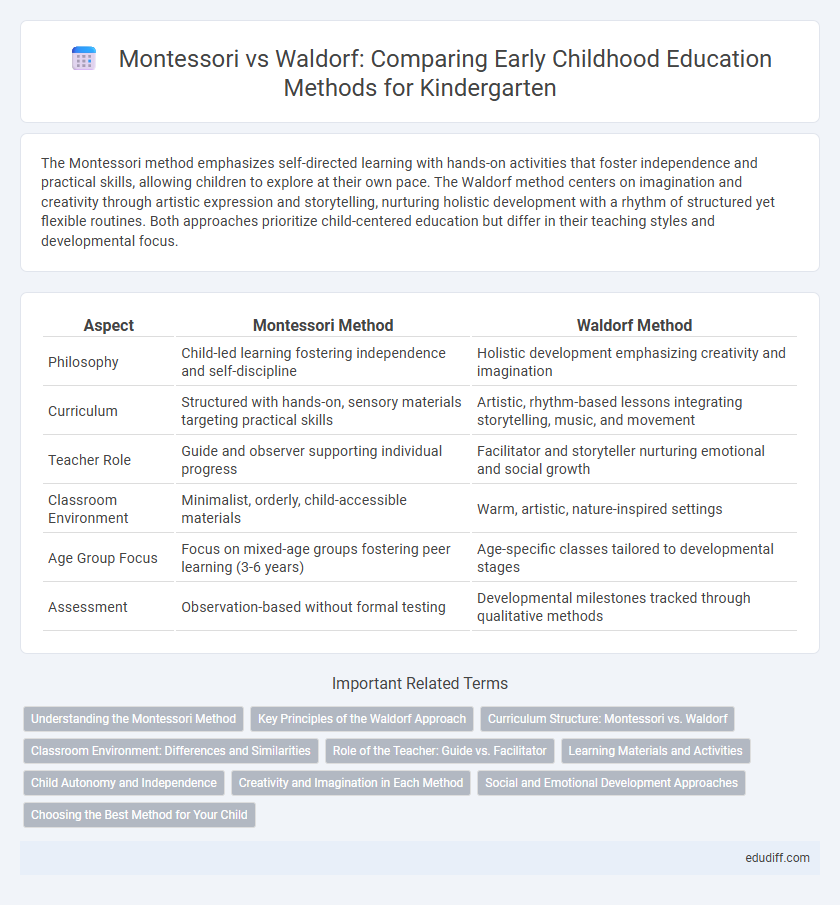The Montessori method emphasizes self-directed learning with hands-on activities that foster independence and practical skills, allowing children to explore at their own pace. The Waldorf method centers on imagination and creativity through artistic expression and storytelling, nurturing holistic development with a rhythm of structured yet flexible routines. Both approaches prioritize child-centered education but differ in their teaching styles and developmental focus.
Table of Comparison
| Aspect | Montessori Method | Waldorf Method |
|---|---|---|
| Philosophy | Child-led learning fostering independence and self-discipline | Holistic development emphasizing creativity and imagination |
| Curriculum | Structured with hands-on, sensory materials targeting practical skills | Artistic, rhythm-based lessons integrating storytelling, music, and movement |
| Teacher Role | Guide and observer supporting individual progress | Facilitator and storyteller nurturing emotional and social growth |
| Classroom Environment | Minimalist, orderly, child-accessible materials | Warm, artistic, nature-inspired settings |
| Age Group Focus | Focus on mixed-age groups fostering peer learning (3-6 years) | Age-specific classes tailored to developmental stages |
| Assessment | Observation-based without formal testing | Developmental milestones tracked through qualitative methods |
Understanding the Montessori Method
The Montessori method emphasizes self-directed learning, sensory-based activities, and mixed-age classrooms to foster independence and natural curiosity in children. It relies on specially designed educational materials that encourage hands-on exploration and concrete understanding of concepts like math, language, and practical life skills. This approach supports individualized learning paces, allowing children to build intrinsic motivation and develop cognitive and social skills through structured freedom.
Key Principles of the Waldorf Approach
The Waldorf approach emphasizes holistic development through imaginative play, artistic expression, and experiential learning to nurture children's creativity and social skills. Its curriculum integrates storytelling, rhythm, and nature-based activities, fostering emotional and spiritual growth alongside cognitive skills. Teachers in Waldorf kindergartens focus on creating a warm, predictable environment that supports children's natural development stages.
Curriculum Structure: Montessori vs. Waldorf
The Montessori curriculum emphasizes self-directed learning with specially designed materials that promote sensory exploration and practical life skills in a structured environment. The Waldorf curriculum follows a holistic, arts-integrated approach where storytelling, imagination, and seasonal rhythms guide age-appropriate activities. Both methods prioritize child development but differ in instructional style and daily schedule flexibility.
Classroom Environment: Differences and Similarities
Montessori classrooms emphasize organized, child-sized materials promoting self-directed learning and independence, while Waldorf environments focus on natural materials with a homelike, artistic setting encouraging imaginative play. Both methods prioritize a calm, nurturing atmosphere tailored to developmental stages, supporting sensory exploration and creativity. The Montessori approach uses specific learning stations to foster autonomy, whereas Waldorf spaces integrate seasonal themes and storytelling to inspire holistic growth.
Role of the Teacher: Guide vs. Facilitator
In the Montessori method, the teacher acts as a guide, carefully observing each child's interests and providing individualized materials to foster independent learning and self-discipline. In contrast, the Waldorf method positions the teacher as a facilitator who creates a nurturing, imaginative environment that encourages creative play and holistic development through storytelling, arts, and social activities. Both approaches emphasize the teacher's supportive role but differ significantly in their strategies to promote child-led exploration and growth.
Learning Materials and Activities
Montessori method uses hands-on learning materials like wooden blocks, sensory tools, and practical life activities to promote independence and fine motor skills. Waldorf method emphasizes natural, imaginative play with organic materials such as wool, silk, and clay, encouraging creativity and emotional development. Both approaches prioritize child-centered learning but differ sharply in the structure and type of learning materials and activities used.
Child Autonomy and Independence
The Montessori method emphasizes child autonomy by providing a structured environment with self-directed learning materials that promote independent decision-making and hands-on exploration. In contrast, the Waldorf method fosters independence through imaginative play and guided activities that nurture creativity and social development within a community setting. Both approaches prioritize child autonomy but differ in their balance between individual freedom and collaborative experiences.
Creativity and Imagination in Each Method
The Montessori method fosters creativity through hands-on, self-directed activities that encourage children to explore materials and develop problem-solving skills independently. The Waldorf method emphasizes imagination by integrating storytelling, artistic expression, and role-playing into daily routines, nurturing a rich inner world and emotional growth. Both approaches prioritize fostering creativity and imagination but employ distinct techniques tailored to developmental stages and individual learning rhythms.
Social and Emotional Development Approaches
The Montessori method promotes social and emotional development through self-directed activities that encourage independence, collaboration, and conflict resolution among children. In contrast, the Waldorf approach emphasizes imaginative play and storytelling, fostering empathy, creativity, and emotional expression within a nurturing community environment. Both methods cultivate social skills, but Montessori prioritizes practical life skills while Waldorf centers on artistic and emotional experiences.
Choosing the Best Method for Your Child
The Montessori method emphasizes self-directed learning with hands-on materials, fostering independence and practical skills, while the Waldorf method nurtures creativity through imaginative play, artistic activities, and storytelling. Choosing the best method for your child depends on their learning style, temperament, and developmental needs, with Montessori suited for children who thrive in structured, sensory-rich environments and Waldorf ideal for those who benefit from rhythm, imagination, and holistic growth. Parents should consider factors such as curriculum focus, teacher involvement, and classroom atmosphere to align educational approaches with their child's unique personality and potential.
Montessori method vs Waldorf method Infographic

 edudiff.com
edudiff.com